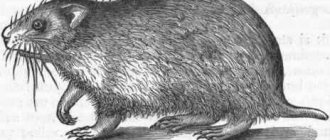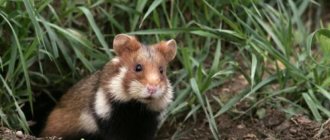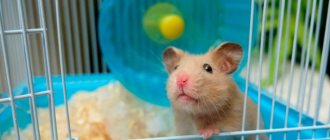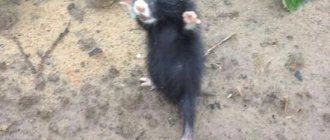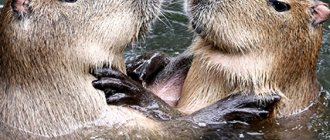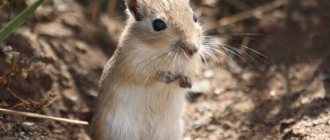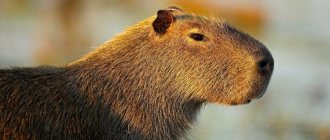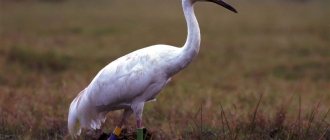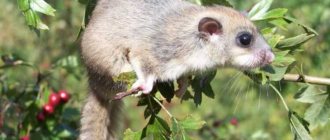Planet Earth is home to a huge number of hamsters and hamsters. They can be found on all continents, with the exception of Antarctica and Australia.
The largest number of varieties of these animals is found in America and on the islands off its coast (subfamily Sigmondontinae) (more information about the types of hamsters here). African hamsters belong to the subfamily Lophiomyinae, and those living in Eurasia belong to the subfamily Cricetinae, family Cricetidae.
The Central Asian (Syrian) hamster is well known as a pet. In the wild, it lives only in a small area in northwestern Syria.
The animals inhabit various biotypes: forests, forest-steppes, steppes, semi-deserts, deserts, savannas, mountains, shores of reservoirs. Many species settle in close proximity to humans.
On the territory of Russia, mainly in the steppe zone, 12 species of these animals are found.
Rat-like hamsters are common in China. Also found in Russia (Amur Region and Primorsky Territory).
Anatomy and appearance
Rodents in nature reach a size of 30-35 cm, body weight reaches 700 g. Females are smaller than males. The body is tightly knit and rounded, the neck is slightly pronounced. The head smoothly transitions into the body. The ears are short and rounded. The tail is short, up to 3-6 cm. At first it is thick, tapering towards the tip.
The front and hind legs are short. The claws are strong and well adapted for digging the ground. Hamsters' teeth gradually wear down and grow back throughout the animal's life. The fur is dense, with a thick undercoat. The predominant color is brown, with large white and black spots. There are animals of gray, sand and black colors.
Rodents have a dense, built-up body.
Their vision is poor, their hearing and sense of smell are well developed. Scent glands are located on the animal's body.
During its travels, the animal rubs its back against objects, leaving an odorous substance on them. Based on the smell, the animal can easily find its way home.
Structural features
Domestic hamsters are tiny mammals that were domesticated by humans centuries ago. Their body, covered with thick fur, consists of a head, a very short neck and a body with limbs and a small tail.
Head structure
You can roughly depict a triangle on the hamster’s face. The lower top is a miniature nose, with cute antennae radiating from it in different directions, which help the animal receive information from the outside world (pressure, air speed, etc.). Above the nose on the left and right are radiant black eyes, and even higher are round, erect ears. By the way, hamsters see rather poorly, but they hear perfectly, so even not very loud sounds can scare them.
A characteristic feature of these pets is their teeth. Hamsters have only 16 of them, with 2 long incisors located below and above, which continue to grow throughout their lives, like other animals from the order Rodents. Hamsters must chew something every day to wear down their front teeth, otherwise their mouth simply won’t close and the animal will die.
Hamster cheeks deserve special admiration. The thrifty fluffy hides the food he hasn’t eaten in them. Homa carries food from the bowl to the house in its cheek pouches. Among the Djungarians they are relatively small, but among the Syrians they are quite spacious; they can hold up to 20 g of grains! The mucous membrane of the cheek pouches is very delicate, so if you feed your hamster rough food, the cheek may become swollen.
Body structure
The body of small rodents is round and covered with thick hair. By its appearance you can judge the health of your pet. The Djungarians have medium-length fur, but the Syrian breed has 2 subspecies. There are ordinary Syrians with short hair and Angoras - very beautiful hamsters with long curls.
The tail of most breeds is short, sometimes it is not even noticeable. And under it, on the ventral side of the body, there are excretory and reproductive organs, and on the sides there are special odorous glands in the form of dark dots, with the help of which the male marks the territory.
Hamsters have a standard set of internal organs for a mammal, but the work of the heart is of particular interest. On average, it beats at a frequency of 300 beats per minute and wears out quickly. Therefore, small rodents do not live long: a 3-year-old animal is already considered old. The frequency of breathing movements depends on the activity at a given time. A sleeping homa takes about 35 breaths per minute, and during exercise or severe stress - 120!
The structure of their legs is also interesting. Many people do not know how many fingers a hamster has.
- there are only 4 toes on the front legs, the fifth does not develop, but can be noticeable as a small rudiment;
- There are five toes on the hind legs.
Hamsters' toes are very tenacious and end in claws, which should be trimmed periodically if the hamster does not gnaw them on its own.
Now you have an idea of what hamsters look like. The body plan is common to all breeds, but the same cannot be said about the size and weight of animals.
Habitats and distribution area
Finding out in which zone the hamster lives is useful for understanding the characteristics of the pet’s life. Although domestic varieties differ in their habits from their wild relatives, similarities exist between them.
Hamsters in the wild inhabit all continents, with the exception of Australia and Antarctica. Favorite habitat is open steppe landscapes. Rodents prefer to settle in warm, dry places, close to a food source. Some species live in close proximity to humans.
Steppe individuals
Many species of hamsters inhabit steppe and forest-steppe regions. They are common in the south of the Russian Federation, China, and Central Asia. The animals live in Eastern Kazakhstan and Western Siberia. The most numerous species of steppe rodents is the dzhungarika. They are well studied and described by scientists. Djungarian hamsters are popular as pets.
Steppe individuals are common in the south of the Russian Federation.
In the wild, the main enemies of steppe rodents are foxes, weasels, and wolves. Birds of prey hunt hamsters - owls, eagles, falcons.
For shelter, the animals dig deep holes in the ground.
Forest hamsters
In North America, there are species that prefer to settle in rocks, under stones and fallen trees. Locals call the rodents tree rats. Animals often set up their shelters not far from humans. This makes them easy prey for dogs and cats.
Field varieties
The distribution range of field rodents in the wild stretches from Southern Europe to the northeastern part of China. This type of animal is often called karbysh. These are quite large animals. The plowing of meadows for agricultural land and active deforestation are reducing their habitat. Field species begin to settle near humans. When numbers increase, rodents can harm the crop.
Field varieties of hamsters are large in size.
Recommendations
- https://animaldiversity.org/accounts/Cricetinae/
- ^ abcdef Fox, Sue. 2006. Hamsters
. TFH Publications Inc. - ^ abcdef Barry, Anmarie. 1995. Hamsters as a new pet. TFH Publications Inc., NJ ISBN 0-86622-610-9.
- ↑
Patricia Pope Bartlett (2003). Hamster Handbook. Barron's Educational Series. paragraph 113. ISBN 978-0-7641-2294-1. - Neumann, K; Michaux, J; Lebedev, V; Yigit, N; Colak, E; Ivanova, N; Poltoraus, A; Surov, A; Markov, G (2006). "Molecular phylogeny of the subfamily Cricetinae based on mitochondrial cytochrome b and 12S rRNA genes and the nuclear vWF gene" (PDF). Molecular phylogenetics and evolution
.
39
(1): 135–48. DOI: 10.1016/j.ympev.2006.01.010. PMID 16483801. - ↑
Lebedev V.S., Ivanova N.V., Pavlova N.K., Poltoraus A.B.
2003. Molecular phylogeny of Palaearctic hamsters. In
proceedings of the International Conference on Taxonomy, Phylogeny and Paleontology of Small Mammals, dedicated to the 90th anniversary of Professor I. M. Gromov (ed. A. Averyanov and N. Abramson). Saint Petersburg. - ^ abcd Fritsche, Peter. 2008. Hamsters: A Complete Guide for Pet Owners. Educational Series Barron's Inc., NY ISBN 0-7641-3927-4.
- ^ abcde Koonen, G. (2002). Comfortable housing for hamsters in research institutions. In Comfortable Facilities for Laboratory Animals, Ed. W. Reinhardt and A. Reinhardt. Animal Welfare Institute, Washington, DC. pp.33–37
- Douglas Harper, Online Dictionary of Etymology
, entry for "hamster" - Merriam-Webster Collegiate Dictionary, st. "hamster" (May 29, 2008) Merriam-Webster.com
- https://www.answers.com/Q/What_is_a_group_of_hamsters_called
- King, LeeAnn Engfer; photographs by Andy (1997). My pet hamster and gerbils
. Minneapolis: Lerner. paragraph 13. ISBN 978-0822522614. - ↑
Thomas A. Scott (1995). Concise Encyclopedia of Biology (Rev. ed.). Berlin: Walter de Gruyter. paragraph 299. ISBN 978-3110106619. - ^ abc "Anatomy | About hamsters | Hamsters | Guide | Omlet US". www.omlet.us
. Retrieved November 20, 2022. - Bartlett, Patricia Pope; Earl-Bridges, Michelle (2003). Hamster Handbook. Barron's Educational Series. clause 21. ISBN 9780764122941.
- ^ a b "Hamster body language and behavior: what does it mean". Pet care
. Retrieved November 20, 2022. - ^ a b "All about keeping hamsters as pets". Spruce pets
. Retrieved November 20, 2022. - "Is this safe for your hamster?" . Spruce pets
. Retrieved November 20, 2022. - ^ab "hamster". Encyclopædia Britannica. Standard version. Chicago: Encyclopedia Britannica, 2007.
- Petri, Inez; Dumbell, Rebecca; Scherbarth, Frank; Steinlechner, Stefan; Barrett, Perry (2014). "Effects of exercise on photoperiod-regulated hypothalamic gene expression and peripheral hormones in the seasonal dwarf hamster Phodopus sungorus". PLOS One
.
9
(3):e90253. Bibcode: 2014PLoSO...990253P. DOI: 10.1371/journal.pone.0090253. PMC 3946023. PMID 24603871. - ^ ab https://www.britishhamsterassociation.org.uk/get_article.php?fname=journal/hibernation.html
- Gattermann, R.; Fritzsche, P.; Neumann, K.; Al-Hussein, I.; Kayser, A.; Abiad, M.; Yakti R. (2001). "Notes on the modern distribution and ecology of wild golden hamsters (Mesocricetus auratus)." Journal of Zoology
.
254
(3):359–365. DOI: 10.1017/S0952836901000851. - Musser, Guy. "Hamster | Facts and breeds". Encyclopedia Britannica
. Retrieved February 1, 2022. - “How soon can you take the hamster away from its mother?” . animals.mom.me
. Retrieved November 20, 2022. - "Leonard Goodwin - Telegraph". Daily Telegraph
. January 14, 2009. Retrieved January 18, 2009. - ↑
Testimony of Grant Riddle (born 1929, lives in Wildwood Lake, California), who had a pet hamster in 1942. - ^ abcd Logsdale, Chris; Logsdale, Peter; Hovers, Keith (2002). Hamsterlopaedia: A Complete Guide to Hamster Care
. Lydney: Ringpress. item 161. ISBN. 978-1860542466.
How wild hamsters live in nature
Rodents living in nature do not tolerate the proximity of other relatives. The hamster has a solitary lifestyle, they are distinguished by aggressive behavior and jealously guard their territory. When in danger, animals can attack animals larger than themselves. At the same time, they stand on their hind legs and make sharp clicking sounds. When attacking, the animals jump onto the enemy. Rodents are active at night. During the day, animals prefer to hide in their shelters.
How to build a home
Rodents live in burrows that can go into the ground to a depth of 2.5 m. The animals are distinguished by their cleanliness and accuracy. They insulate the floor of the house with leaves and grass. Periodically, rodents change their bedding to fresh ones. The hole consists of a living space where the animal sleeps, storage rooms for storing supplies, an entrance and several emergency exits. Rodents use food reserves during the cold season. In summer and autumn, hamsters prefer to eat fresh food.
Life expectancy in the wild
In nature, hamsters live from 2 to 4 years. Animals in the wild face many dangers. The main threats to the animals are humans, predators and lack of food. Many animals die without having time to leave offspring. The high fertility of rodents helps maintain the population size.
The lifespan of hamsters is from 2 to 4 years.
Diet of a wild rodent
Hamsters are omnivores, but they prefer plant foods. The basis of the summer diet is cereals, root vegetables, and greens. The animal loves to eat insects. Large field hamsters - carbysh, can eat lizards, newts, small mice and shrews.
In winter, the animals eat reserves made during the warm season. In rodents' pantries you can find nuts, grains, vegetables, and root vegetables. One animal stores up to 10 kg of food for the winter. In some of their bins they found up to 90 kg of food.
Reproduction in nature
Animals are highly fertile. Upon reaching 2 months of age, the female is able to bear offspring. Partners find each other by smell. The mating season lasts up to 24 hours. During this time, the male and female retire to a hole where mating occurs. Then the animals separate. In the future, males do not take part in caring for the offspring.
Expectant mothers bring babies into the world after 17-20 days. There are an average of 5-8 cubs in a litter. Hamsters are born blind and helpless, but grow quickly. After 14 days, they begin to explore the world around them and leave the house. During the year, 1 female brings 2-3 litters.
Wintering
With the onset of cold weather, the animals stop leaving their holes. In mid-October, rodents hibernate. Hamsters are sensitive sleepers. Periodically, the animal awakens and is refreshed with food reserves, which are stored in pantries. During the thaw, the animal can even go outside for short walks. In spring, the animals wake up and regularly leave the hole in search of fresh food.
In winter, the animal periodically wakes up.
Reproduction of the animal
When winter has passed and the frost has receded, the hamster begins to look for a female. Since all brothers do this, there is a high chance of running into a competitor. The rodent is looking for the female's hole, but often there is already another candidate to become the father there. In this case, the strongest will receive it, the winner will be determined in battle. When the loser retreats, our hero marks the hole. Only with the consent of the female does the process of reproduction of the common hamster begin. After which he returns to his native hole.
Pregnancy lasts 3 weeks, after which 4-12 small hamsters are born. But it happens that there can be 20 individuals in one. One female can give birth up to three times in a year. The babies weigh only 5 grams and are born naked and blind. Only after 1-2 weeks the eyes appear and the fur begins to grow. A month later, the babies are already completely independent and leave their native nest to begin their own journey. In just 2 months, the offspring reaches adult age and size. Some females are able to reproduce within a month and a half after birth. Thus, the population is growing rapidly.
Are there fundamental differences between wild and domesticated individuals?
Domestic and wild rodents have similar body structures, but the animals differ greatly in size. Karbysh is much larger and heavier. The ears of wild species are more massive and clearly visible on the head. The color of the animals is also different; pets often have a beige, golden or white coat. In wild relatives, the body is covered with brown fur with large black and light spots.
The nature of the animals also varies greatly. Pets are calm, peaceful animals. They get used to the presence of a person and allow themselves to be picked up.
Wild individuals are unpredictable and aggressive. They do not tolerate proximity to other animals. A field hamster can bite a person; picking it up is dangerous. This is a wild animal that is very difficult to tame.
Is it a protected animal?
In recent years, the hamster population has declined sharply. Scientists attribute this to a decrease in female fertility. Previously, the litter consisted of 10-12 cubs. Now their number has decreased to 3-6 individuals. This is due to the active use of pesticides by humans in agriculture.
Until the middle of the 20th century. In Europe and the USSR, animals were hunted for their fur. Massive fishing and the active use of pesticides in agriculture have also led to a reduction in the number of rodents.
In some European countries, the wild hamster is on the verge of extinction. In France, Belgium, Poland, and Germany, rodents are protected. Measures are being taken to restore the animal population. A decrease in the number of rodents has been recorded in Russia. In 5 constituent entities of the Russian Federation, the hamster received conservation status. Animals are protected in Tatarstan, Tambov, Nizhny Novgorod, Penza and Lipetsk regions.
In some countries the hamster is on the verge of extinction.
Is it possible to keep a wild hamster in captivity?
Rodents living in nature differ from pets in size and disposition. These are wild animals not suitable for living in a domestic environment. If you catch a baby hamster in a forest or field, there is a chance that it will be able to adapt to people. It is more reasonable, however, not to commit violence against a wild animal, but to purchase a Junagric or Syrian hamster at a pet store.
If you still want to have a rodent at home, you should prepare a home for it. A medium-sized cage with a metal grill will do. It needs to provide a shelter, a place for a toilet, a feeding trough and a drinking bowl. You also need to put pieces of cardboard, fabric and paper. From these the animal will build its own nest. The floor is covered with sawdust. You can feed the animals with special food for rodents.
They eat vegetables and grains. The cage should be cleaned regularly. The water in the drinking bowl is changed daily with fresh water.
Cognitive Features
For rodents, it is difficult to formulate a general description of their mental capabilities. Here everything depends on the breed, conditions of detention, and the age at which the animal was taught to be handled. The frequency of communication with the owner and the types of games that were offered to the pet are of great importance.
You will be interested to know what kind of memory these fluffies have. Scientists have proven that cheekies are able to remember events, which affects their behavior in a certain situation. For example, some Homas perform a ritual of greeting their owner: they go to the edge of the cage and quietly squeak or rub their paws. At the same time, having noticed a stranger, the same animal hides in the house.
Good memory is also evidenced by the fact that rodents begin to respond to their name over time. You just need to choose a short nickname and repeat it more often.
Sometimes there are talented hamsters that are very trainable. This phenomenon is based not only on the good memory of rodents, but also on their natural curiosity. If you place a tasty treat at the end of the maze, the homa will definitely find it. Next time he will cover the same path even faster, which proves the ability of these pets to learn.
In order for the learning process to go well, you should choose the right time for classes. Animals with a twilight lifestyle do not like to be disturbed in the morning or during the day, but training can begin in the evening.
How to catch a wild hamster
Special live traps and traps are used to catch rodents. Structurally, they do not differ from devices for catching mice and rats. Vegetables and root crops are used for luring. The size and strength of the animals should be taken into account. The hamster is a large animal; when catching it, you must be careful and careful.
Special cages are used to catch hamsters.
Etymology
The name "hamster" is a German loanword that comes from the earlier Middle High German hamastra
.
It may be related to the Old Church Slavonic khomestoru
, which is a mixture of the root of Russian khomiak (
khomyak
) "hamster" and the Baltic word (cf. Lithuanian
staras
"hamster");
[9] or of Persian origin (cf. Av hamaēstar
"oppressor").
[10] The collective noun for a group of hamsters is "horde". [11] [ need better source
]
Agro-industry and wild hamsters
Wild rodents feed on roots, vegetables and grains. Multiplying animals can harm the crop.
Damage to crops
A rodent that settles in a country house or garden can bring a lot of trouble to a person. The animals happily eat crops. The harvest of carrots, beets, and potatoes suffers from the invasion of pests. Animals take beans, peas, and grain from the gardens to their pantries.
Rodent control methods
Getting rid of rodents is not easy. Hamsters are careful and smart animals. Many methods have been developed to combat them. The best effect is achieved by using several methods simultaneously.
The industry produces chemicals for the extermination of rodents. First you need to find where the hamster lives. The poison is then placed near the detected pest burrows. Products designed to control rats and mice are used. The method is inhumane, but effective. Disadvantage: Poisoned bait can be accidentally eaten by pets.
Live traps and mechanical traps are actively used to catch rodents. Unlike mice, a hamster is timid and is more difficult to lure into a trap. Flooding the hole with water has a good effect. First you need to find out where the shelter is. Then you should find all the emergency exits. They must be blocked to prevent the animal from escaping. After this, they begin to pour water into the hole. After some time, the animal will leave the shelter. At this moment the rodent is easy to catch.
Getting rid of wild hamsters is very difficult.
A modern way of pest control is the use of repellers. The devices produce sounds in a frequency range that people cannot hear, but cause anxiety in animals. As a result, the animals leave the plot after some time. This is an effective and humane method. The disadvantage is the cost of purchasing expensive devices. For a large area, it may be necessary to install several repellers.
Prevention of occurrence
To prevent the appearance of rodents in your garden or dacha, it is recommended:
- do not allow waste to accumulate in the garden;
- remove root crops and vegetables to the basement or home after harvest;
- plant plants in the garden whose smell repels rodents - chamomile, mint, tansy;
- get a large cat or dog - these animals can scare away pests.
How can you get infected from a wild hamster bite?
Wild rodents are natural carriers of many diseases. The bite of the animal is dangerous for humans and domestic animals. The rodent's teeth are sharp and leave deep, poorly healing wounds. The saliva of animals contains pathogens of about 30 diseases.
Fleas live in fur and carry salmonella, tularemia, brucella and other infections.
If you are bitten by a wild hamster, you should rinse the wound thoroughly with running water. Then treat the skin with disinfectants - hydrogen peroxide or iodine. Sometimes after a bite the victim’s body temperature rises. To avoid serious consequences, it is recommended to seek qualified help at a medical center or hospital as soon as possible.
Interesting facts about the life of hamsters in nature
Hamsters are funny animals. While observing the animals, people learned many interesting facts about their life and habits:
- animals are able to swim well by taking air into their cheek pouches;
- in winter, rodents periodically wake up to eat food stored in the pantry;
- hamsters prefer to live in dry, well-warmed places by the sun;
- peak activity occurs at night;
- in Vietnam there is a law prohibiting the keeping and breeding of animals at home to prevent the spread of infectious diseases;
- they protect their territory from their relatives and do not hesitate to rush into a fight when other individuals invade;
- Rodents have very poor eyesight, they are nearsighted and unable to distinguish colors;
- Hamsters have excellent hearing, which helps them avoid danger.
The hamster is an unusual and interesting animal. Despite their close relationship with domestic pets, wild individuals differ from them in lifestyle, size and character.
